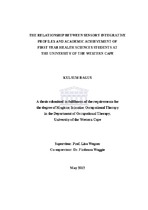| dc.contributor.advisor | Wegner, Lisa | |
| dc.contributor.advisor | Waggie, Firdouza | |
| dc.contributor.author | Bagus, Kulsum | |
| dc.date.accessioned | 2016-06-23T13:18:24Z | |
| dc.date.available | 2016-06-23T13:18:24Z | |
| dc.date.issued | 2012 | |
| dc.identifier.uri | http://hdl.handle.net/11394/5094 | |
| dc.description | >Magister Scientiae - MSc | en_US |
| dc.description.abstract | There is a high incidence of dropout in the first year of university studies. Some
of the main reasons were attributed to adjustment or adaptation difficulties
experienced by the new students which impacted on academic achievement.
Much of this difficulty relates to the need to find their identity in relation to the
new university environment with new rules, peers, and expectations. The
acquisition of a sensory integrative (SI) profile could shed light on an element of
the student’s identity. However, very little is known about the relationship
between the SI profile and academic achievement. Therefore, the aim of the study
was to determine the SI profiles of students and whether there was a relationship
between the SI profiles and academic achievement of first year students from the
Faculty of the Community and Health Sciences (FCHS) at the University of the
Western Cape (UWC).The study followed the quantitative research paradigm and was more specifically a descriptive, cross-sectional study. Measurements included a demographic questionnaire to gather socio-demographic data, as well as the Adolescent and Adult Sensory Profile questionnaire to determine the SI profiles of the students.These instruments were administered to a sample of 357 registered first year students from the FCHS at UWC. Matriculation academic marks, as well as first year university academic marks were obtained and utilised for analysis. The
SPSS statistical package was utilised for descriptive and inferential statistical
analyses of the data. The results of the study indicated that the SI profiles of the first year FCHS students were that they responded "similarly to most people" on each of the four sensory quadrants of Dunn's (1997) Model of Sensory Processing. Secondary analyses were implemented by means of a collapsing mechanism to denote more specific results of the SI profiles. This analysis revealed that the students tended to have low thresholds for their neurological and behavioural continua of sensory processing.The inferential analyses that were implemented to determine whether there was a relationship between the SI profiles and academic achievement of the first year students yielded no statistical relationship between those variables. The analyses revealed relationships between the SI profiles and certain socio-demographic factors, such as age, race, and course of study.In conclusion, the research study uncovered the SI profiles of the first year university student sample, relationships between the SI profiles and sociodemographics and disproved a relationship between SI profiles and academic achievement. The study was therefore of value to the professions of occupational therapy and higher education and has opened avenues for further exploration. Furthermore the study has portrayed that occupational therapy tools and SI profiles could have a place in higher education and in relation to student development, teaching and learning. | en_US |
| dc.description.sponsorship | National Research Foundation (NRF) | en_US |
| dc.language.iso | en | en_US |
| dc.publisher | University of the Western Cape | en_US |
| dc.subject | Neurological thresholds | en_US |
| dc.subject | Sensory integration | en_US |
| dc.subject | Sensory integrative profiles | en_US |
| dc.subject | Academic achievement | en_US |
| dc.subject | First year students | en_US |
| dc.subject | Health sciences | en_US |
| dc.title | The relationship between sensory integrative profiles and academic achievement of first year health sciences students at the University of the Western Cape | en_US |
| dc.rights.holder | University of the Western Cape | en_US |

